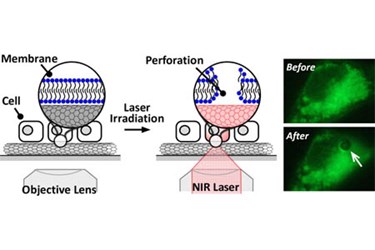Carbon Nanotubes For Cheap, Accurate Cell Manipulation
By Chuck Seegert, Ph.D.

Perforating cell membranes is a key part of effective gene transfection or drug delivery, and a Japanese research team has found a way to do it accurately and inexpensively.
Some cornerstone methods of cell engineering require the introduction of genes or drugs to cells. Sometimes, it is even necessary to do this on a single-cell level. Near infrared (NIR) lasers are used facilitate these experiments by perforating a cell’s membrane with small holes. These holes increase the permeability of the cell to the agents that researchers are administering, thus increasing the efficiency of the treatment uptake.
While there are many wavelengths of lasers available for cell manipulation, NIR is most often chosen because its energy is least absorbed by the cells, preventing undesirable collateral damage. According to a recent press release, the most effective NIR lasers have femtosecond control, which provides them with extremely accurate spatial resolution and limits thermal or mechanical damage to surrounding areas. Unfortunately, however, femtosecond lasers are expensive, and they require complex optical systems to control them and large amounts of space to accommodate the equipment. This was the problem a research team from Kyushu University set out to resolve.
In their research study published in Science and Technology of Advanced Materials, a coating of single-walled carbon nanotubes was used to interact with cell membranes. Nanotubes are strong absorbers of NIR energy and are able to transmit it to cells with some accuracy as long as the energy doesn’t exceed certain levels. Lasers that were pulsed at 17.5 microjoules or greater led to membrane disruption and cell death, while about lasers pulsed at 15 microjoules led to membrane perforation and continued cell viability.
The presence of the nanotubes made it possible to change the laser required to perform this cell membrane operation. Because of the strong absorbance of NIR by the carbon nanotubes, the use of a less expensive and easier-to-operate nanosecond lasers was possible. According to the press release, the authors believe that this will allow for a much less expensive approach for the preparation of single cells in the cell engineering arena.
Image Credit: Science and Technology of Advanced Materials
